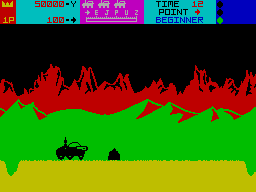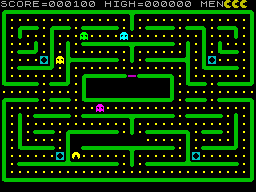ZX Spectrum Star Trader
This
classic game was a space trade em up released for the
ZX Spectrum by good old Bug Byte software in 1984. They actually had the gall to call it 'The highest plateau yet reached in Spectrum software'!
Now it was a decent enough
computer game, but the highest plateu? Not quite...
On start up you would 'enter a galaxy more complex and enthralling than any previously experienced.'
As you may have guessed, the game was in the 'Elite' mould (and came well before that landmark game on the
Speccy) and you had to trade, fly and shoot your way around eight planets.
The game switched between wandering around the planets surface buying and selling goods (and eating and drinking to stay alive) and flying across the stars (with some fairly impressive
3D arcade action for the time) to land on another planet to hopefully make a profit.
All enjoyed in the 'most advanced 3D graphics yet attained on a Spectrum.' Ahem.
 |
| Star Tradin' across the universe... |
A great back story would set the
game scene.
A long time ago in a distant galaxy...
Are colonies of men on small inhabitable planets in neighbouring star systems. Over the years these communities have learned to rely on each other for trade.
Marauding pirates have been quick to take advantage of the strong inter-dependence of the planets, and patrol the interplanetary routes.
In fact, it has come to the point where interstellar trading is a risky line of work, though profits, as ever, can be made.
As a result of a recent increase in the pirates' greed (their self-imposed "tax" on captured ships is now 1/4 of the ships cargo), all the remaining traders have left the system. All, that is, except you...
You alone must attempt to vanquish these rogues, whilst keeping the vast interplanetary economy intact. So no pressure then.
TRADING:
There are eight planets to visit and to buy and sell your goods. They each have eight
major industries, which buy and sell goods to you.
You begin the game with an amount of cash and a space ship. You must use your cash wisely, to purchase goods at low prices on producing worlds, so that you may then sell your wares at a suitable profit on consumer worlds. Not immediately easy and
gameplay perserverence is required.
Planets with poor supplies of any commodities will suffer from quick inflation, which you may use to your money making advantage. If inflation rises to a chaotic level, social unrest will lead to a complete collapse of civil order; so various people will turn to piracy for as a new source of income.
You have a limited storage capacity in your cargo hold, which you have to keep an eye on. You may only buy and sell your goods during normal business hours, outside of which you will find all shops closed. (They even close at lunchtime!)
The main legal tax on your profits is from the customs officials, who will charge you a sh*t load of duty on your wares. You may try to cheat these officials of their dues (by declaring nothing), but at great peril should you be caught (you are looking at jail time and being 'bashed in').

LIVING:
To stay alive during the game you must eat and drink at regular intervals (it can get a little annoying to be told you are hungry after eating a pub dinner along with a pint of beer!). Failure to do so will cause starvation, and eventually death!
You may stay overnight at an inn or a hotel to reduce your chances of being mugged, although it still can happen whilst you are snoring away in a holiday space-inn.
You should also take a quantity of food packs to eat during space flight between planets. These food packs can be bought from the local supermarket.
PIRATES:
The worst hazard to the
game player is being attacked by a pirate band - the height of scum and villany. You may protect yourself though by buying armaments for your ship. You will need
a laser and at least one battery pack to powre up the laser if you intend fight these space bound vagabonds.
This is the
arcade portion of the game. The
arcade action is viewed from your spaceship front windows, with the enemy craft approaching.
You can move your vessel up, down, right, left and (taken from the inlay instructions was quite something for the time 'so, for instance, if you choose to move left, the enemy craft will drift rightwards past your windows, just like driving a car!'). Amazing stuff I'm sure you'll agree.
If the fight is not going well (as in your shields are fully depleted) you can always surrender and pay the pirates their 'tax'. It can actually work out cheaper to do this rather than buying a lazer and an eight pack of ever-ready. Your shields always have to be repaired too when you land at your destination - so my advice is to avoid space combat and just pay any pirates you bump into.
Watch out for civil unreset on a planet - if society collapses and war breaks out you are immediately killed and the game is over. Keeping the economy secure across all eight planets is no mean feat....
 On Release:
On Release:This game was generally well met, but was never considered a must have. It managed to combine trading elements with
arcade action quite well, and the menu screens were easy enough to follow. It was quite a popular game, but every Speccy users wanted Elite (I was jealous of my mate and his
BBC Micro) - they would have to wait a little longer and this game filled the void for a while.
The Test Of Time:Well, it's a charming game for sure. Very much a true
retro game, this one is quite dated, more so than many other games from 1984. Having said that, there is something that is still enjoyable about playing it. Buying and selling is fun for a while, and the different random things that can happen through the
game are both funny and frustrating (such as being mugged and having cash stolen, being thrown in jail, being mugged but being too strong for your attackers, spending a bucket load of cash on food but no matter how much you eat you are still hungry...)
Once you get over trying to use your mouse to make menu selections and get back into old school menu selection then progress can be made. Transport yourself back to a time when eight planets seemed almost limitless and when your imagination made each shopkeeper look different...
It's not quite Elite, but it's a quirky little
computer game. Not bad. I always thought the spaceport looked quite cool too.
GENRE: Space strategy game/
Arcade GameRELEASE DATE: 1984
RELEASED BY: Bug Byte
DEVELOPER(S): Trevor Hall, Rob Phoenix,Gary McNamara and Joey
PRICE: £6.95 - UK
Classic gaming in the 'Elite' mould...
Classic Games,
Arcade Games and
ZX Spectrum Games












